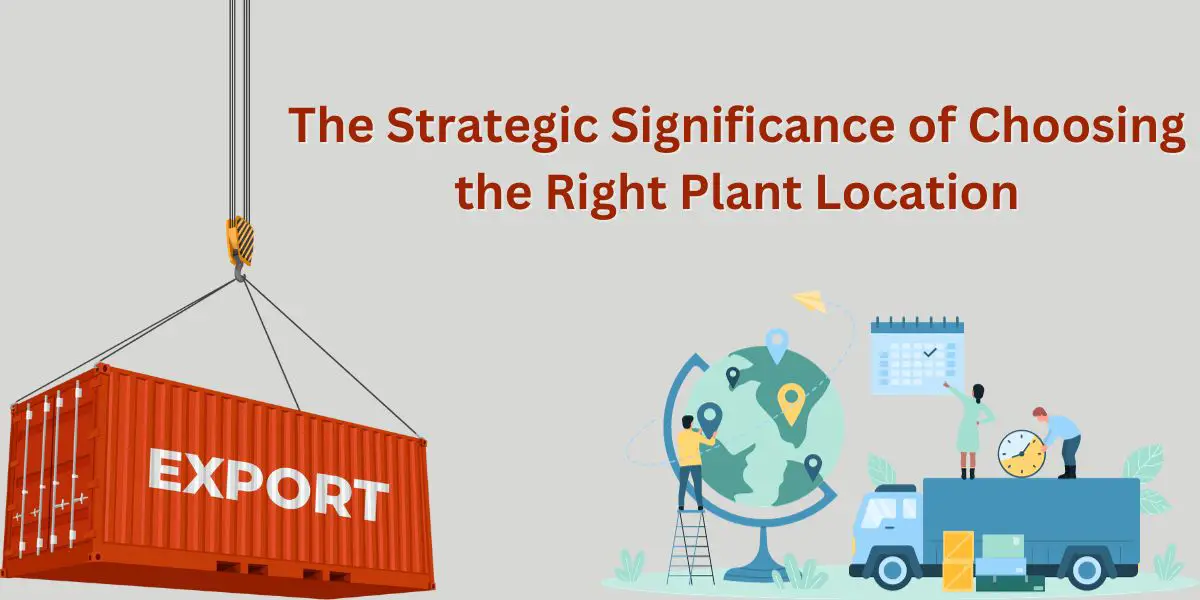In the dynamic landscape of business operations, the importance of plant location cannot be overstated. As companies expand their footprint globally, the decision of where to establish manufacturing facilities plays a pivotal role in their success. Let’s delve into the intricate details of why plant location is importance or a critical factor in today’s business environment.
Introduction
A. Definition of Plant Location
Plant location refers to the geographical placement of a manufacturing facility. It involves a strategic decision-making process that considers various factors to optimize operational efficiency and minimize costs.
B. Significance in Business Operations
The location of a plant directly impacts supply chain management, production costs, and overall competitiveness in the market. It goes beyond mere geography; it involves a comprehensive analysis of economic, strategic, and environmental factors.
Factors Influencing Plant Location
A. Economic Factors
1. Cost of Labor
The cost of labor in a specific region significantly affects the decision to establish a manufacturing plant. Low labor costs may seem enticing, but other factors must be considered to ensure long-term sustainability.
2. Transportation Costs
Proximity to raw materials and markets helps minimize transportation costs, a crucial consideration in the decision-making process.
B. Infrastructural Considerations
1. Accessibility
The ease of accessibility to transportation networks is essential. A well-connected location ensures the smooth flow of goods in and out of the plant.
2. Utilities
Availability of utilities, such as water and electricity, is critical for uninterrupted production. Plants located in regions with reliable infrastructure are better equipped to handle operational challenges.
C. Regulatory Environment
1. Compliance and Regulations
Understanding and adhering to local regulations is vital. Regulatory compliance ensures that the plant operates within legal frameworks, avoiding potential legal issues.
2. Taxation
Tax policies vary across regions and can significantly impact operational costs. Choosing a location with favorable tax incentives can contribute to cost-effectiveness.
Also Read: Role of Management Accounting in Decision Making
Strategic Aspects of Plant Location
A. Market Proximity
Being close to the target market reduces transportation time and costs, enabling companies to respond more quickly to consumer demands.
B. Supply Chain Optimization
1. Raw Material Availability
Proximity to raw material sources minimizes lead times and reduces dependency on external suppliers.
2. Distribution Efficiency
Optimizing the supply chain through strategic plant location ensures timely and cost-effective distribution of finished goods.
Impact on Production and Efficiency
A. Resource Utilization
Strategic plant location allows for efficient utilization of resources, contributing to increased productivity and reduced waste.
B. Production Costs
A well-thought-out location strategy can significantly impact production costs, making the business more competitive in the market.
C. Scalability
Choosing a location with scalability in mind allows for future expansion without the need for a complete overhaul of the supply chain.
Technological Advancements in Plant Location
A. Industry 4.0 and Smart Manufacturing
Advancements in technology, such as Industry 4.0, play a pivotal role in optimizing plant location decisions through data-driven insights and automation.
B. Data Analytics for Decision-Making
Utilizing data analytics helps in making informed decisions, enabling businesses to adapt to changing market dynamics.
Environmental Considerations
A. Sustainable Practices
Choosing environmentally sustainable locations aligns with the growing global emphasis on corporate social responsibility.
B. Ecological Impact Assessment
Conducting ecological impact assessments ensures that plant operations are in harmony with the surrounding environment.
Also Read: Direct Educational Services: The Secret to Academic Success
Globalization and Plant Location
A. International Expansion
Globalization has led to the expansion of manufacturing facilities across borders, requiring a nuanced understanding of international business environments.
B. Cross-Border Challenges and Solutions
Navigating challenges associated with cross-border operations demands strategic planning and effective solutions.
Future Trends in Plant Location
A. Remote Manufacturing Facilities
The rise of remote manufacturing facilities, facilitated by advancements in technology, presents new opportunities and challenges.
B. Resilience and Adaptability
Future plant location strategies must prioritize resilience and adaptability to navigate uncertainties.
Recommendations for Businesses
A. Strategic Decision-Making
Businesses should adopt a holistic approach to plant location, considering both short-term and long-term implications.
B. Continuous Evaluation and Adaptation
Regularly reassessing plant location strategies ensures alignment with evolving business goals and market dynamics.
Conclusion
In conclusion, the importance of plant location extends far beyond geographical coordinates. It is a strategic decision that influences economic viability, operational efficiency, and environmental sustainability. As businesses navigate the complexities of a globalized market, choosing the right plant location becomes a key determinant of success.
Also Read: Generative Drive: Revolutionizing Creativity and Innovation
FAQs
Q1: How does the cost of labor impact plant location decisions?
A1: Labor costs play a crucial role in determining the financial viability of a plant location. Low labor costs may seem attractive, but other factors must be considered for long-term success.
Q2: Why is market proximity essential in plant location?
A2: Proximity to the target market reduces transportation costs and allows for quicker response to consumer demands, contributing to overall business efficiency.
Q3: How do technological advancements influence plant location decisions?
A3: Technology, especially Industry 4.0 and data analytics, provides valuable insights for optimizing plant location decisions and enhancing operational efficiency.
Q4: What role does sustainability play in plant location strategies?
A4: Sustainability considerations are increasingly important, with businesses prioritizing environmentally friendly practices to align with global expectations of corporate responsibility.
Q5: How can businesses ensure adaptability in their plant location strategies?
A5: Continuous evaluation and adaptation of plant location strategies are essential, allowing businesses to stay agile and responsive to changing market dynamics.



